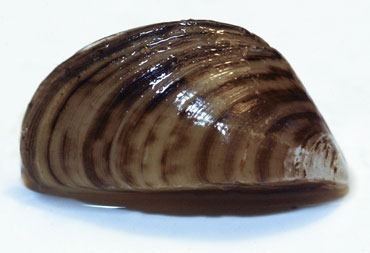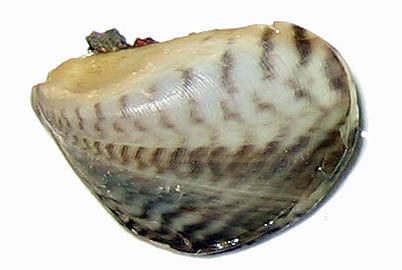Subclass Heterodonta Rank Species | Order Veneroida Higher classification Dreissena | |
 | ||
Similar Zebra mussel, Dreissena, Quagga, Dreissenidae, Round goby | ||
Quagga mussels feeding speeded up 10x
The quagga mussel, scientific name Dreissena bugensis, and also known as Dreissena rostriformis bugensis, is a species (or subspecies) of freshwater mussel, an aquatic bivalve mollusk in the family Dreissenidae.
Contents
- Quagga mussels feeding speeded up 10x
- Silent invaders episode 2 zebra quagga mussels
- Appearance
- Diet
- Reproduction
- Invasive species
- Quagga mussels as prey
- References

This freshwater mussel has an average life span of 3 to 5 years.
This subspecies is indigenous to the Dnieper River drainage of Ukraine. The species is named after the quagga, an extinct subspecies of African zebra, possibly because, like the quagga, its stripes fade out towards the ventral side.
The quagga mussel is currently of major concern in the Great Lakes of North America as an invasive species brought by overseas shippers that use the St. Lawrence Seaway.

Silent invaders episode 2 zebra quagga mussels
Appearance

The quagga mussel shell is striped and/or zig-zagged, as is that of the zebra mussel, but the quagga shell is paler toward the end of the hinge. There is a large range of shell morphologies, including a distinct morph in Lake Erie that is pale or completely white. The quagga is slightly larger than the zebra mussel, about 20 millimetres (0.8 in) wide, roughly about the size of an adult human's thumbnail. The quagga has a rounded carina and a convex ventral side.
Diet
The quagga mussel is a filter feeder. It uses its cilia to pull water into its shell cavity through an incurrent siphon and it is here that desirable particulate matter is removed. Each adult mussel is capable of filtering one or more liters of water each day, where they remove phytoplankton, zooplankton, algae, and even their own veligers. Any undesirable particulate matter is bound with mucus, known as pseudofeces, and ejected out the incurrent siphon. The particle-free water is then discharged out the excurrent siphon.
Reproduction

The quagga mussel is a prolific breeder, possibly contributing to its spread and abundance. Dreissena are dioecious (either male or female) with external fertilization. A fully mature female mussel is capable of producing up to one million eggs per year. After fertilization, pelagic microscopic larvae, or veligers, develop within a few days and these veligers soon acquire minute bivalve shells. Free-swimming veligers drift with the currents for three to four weeks feeding by their hair-like cilia while trying to locate suitable substrata to settle and secure byssal threads. Mortality in this transitional stage from planktonic veliger to settled juveniles may exceed 99%.
Invasive species
Zebra mussels, the first dreissenid mussel introduced in North America, rapidly spread throughout many major river systems and the Great Lakes, causing substantial ecological and environmental impacts. The quagga mussel was first observed in North America in September 1989 when it was discovered in Lake Erie near Port Colborne, Ontario. It was not identified as a distinct species until 1991.
The introduction of both dreissenid species into the Great Lakes appears to be the result of ballast water discharge from transoceanic ships that were carrying veligers, juveniles, or adult mussels. The genus Dreissena is highly polymorphic and prolific with high potential for rapid adaptation attributing to its rapid expansion and colonization. Still, there are other factors that can aid in the spread of these species across North American waters, such as, larval drift in river systems or fishing and boating activities that allow for overland transport or movement between water basins. The success of overland transport of Dreissena species depends on their ability to tolerate periods of desiccation, and results suggest that, given temperate summer conditions, adult Dreissena may survive 3-5 days of aerial exposure.
Quaggas are prodigious water filterers, removing substantial amounts of phytoplankton and suspended particulate from the water. By removing the phytoplankton, quaggas in turn decrease the food source for zooplankton, therefore altering the food web. Impacts associated with the filtration of water include increases in water transparency, decreases in mean chlorophyll concentrations, and accumulation of pseudofeces. Water clarity increases light penetration causing a proliferation of aquatic plants that can change species dominance and alter the entire ecosystems. The pseudofeces that is produced from filtering the water accumulates and impacts the environment. As the waste particles decompose, oxygen is used up, water acidity increases (decreased pH) and toxic byproducts are produced. In addition, quagga mussels accumulate organic pollutants within their tissues to levels more than 300,000 times greater than concentrations in the environment and these pollutants are found in their pseudofeces, which can be passed up the food chain, therefore increasing wildlife exposure to organic pollutants (Snyder et al., 1997). Another major threat involves the fouling of native freshwater mussels. Since quaggas were discovered in Lake Michigan in 1998, plankton rings formed by the passage of storms have been eaten away by the quagga mussels, threatening the local ecosystem.
Each coin-sized quagga can filter up to a liter of water per day, stripping away the plankton that for thousands of years directly and indirectly sustained the native fish. Much of that food supply has now been sucked to the lake bottom; for every pound of prey fish swimming in the lake today, there are an estimated three or four pounds of quaggas clustering on the lake bed.
Dreissena's ability to rapidly colonize hard surfaces causes serious economic problems. These major biofouling organisms can clog water intake structures, such as pipes and screens, therefore reducing pumping capabilities for power and water treatment plants, costing industries, companies, and communities. Recreation-based industries and activities have also been impacted; docks, breakwalls, buoys, boats, and beaches have all been heavily colonized. Many of the potential impacts of Dreissena are unclear due to the limited time scale of North American colonization. Nonetheless, it is clear that the genus Dreissena is highly polymorphic and has a high potential for rapid adaptation to extreme environmental conditions, possibly leading to significant long-term impacts on North American waters. Also, the colonization of deeper water by D. r. bugensis, exposes the quagga to a new range of environmental conditions and new habitats.
It causes many of the same problems (stripping life-supporting algae, damaging boats, power plants, and harbors and destroying the native mussel population) as the equally invasive zebra mussel of Russia. It is also displacing native burrowing amphipod (Diporeia hoyi) from the deep waters of Lake Erie.
In January 2007, quagga mussels were discovered at a marina in the Nevada portion of Lake Mead, and two other lakes on the Colorado River, Lake Mohave and Lake Havasu.
In 2008 the threat of quagga mussels being introduced at Lake Casitas and Westlake Lake in California from recreational boating resulted in the lakes banning the use of outside boats. As of March 2008, other lakes such as Castaic and Lake Cachuma are considering similar bans. In June 2008, the mussels were confirmed in Lake Granby, Colorado. The larva form of quagga mussels were found in the water. After 5 years of negative testing Lake Granby, Colorado has been classified as a negative waterbody for quagga mussel veligers.
In 2014, the species was reported at Wraysbury reservoir, not far from London's Heathrow Airport in the valley of the River Thames.
Quagga mussels are now in all parts of Lake Powell on the Utah and Arizona Border. They are also now suspected in Deer Creek Reservoir at the top of Provo Canyon in Utah.
Quagga mussels as prey
In 1994, invasive species biologist Anthony Ricciardi determined that yellow perch found the invasive dreissenid species palatable. In 2004, he determined that yellow perch, over the intervening 10 years, had developed an appetite for the Quagga mussel. While this sounds like good news, the problem is that this feeding process introduces contaminants into the food chain, notably Clostridium botulinum.
Redear sunfish, a specialized mollusc-eating fish, are now being stocked in the Colorado River drainage as a defense against the quaggas. As with the yellow perch, this predator–prey relationship could cause toxins and microorganisms to move up the food chain.
Although quaggas are edible for humans, eating them is not recommended due to the accumulation of toxins, pollutants, and microorganisms within the mussels' bodies.
